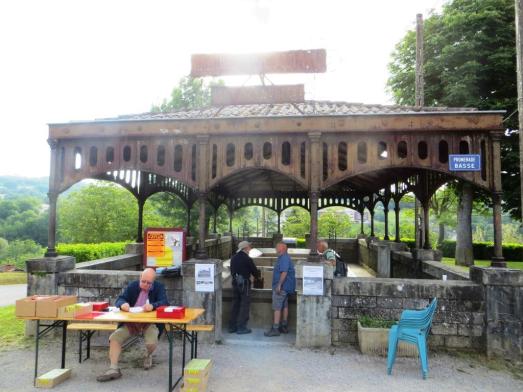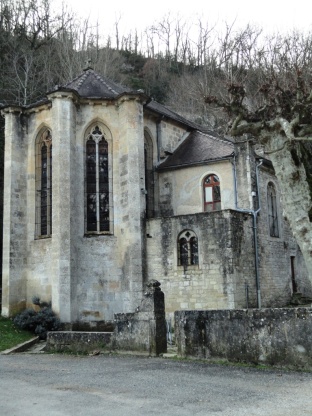
Our village formerly held an annual car rally. This wasn’t a race with souped-up vehicles – fortunately – but a “rallye touristique”, i.e. following a circuit between checkpoints around the commune. The event faded, as these things do, but a local association, Caylus Notre Village, revived it this year. The rally was in support of their project to restore the village’s unique lavoir (wash-house).
The SF and I took part. This could have led rapidly to divorce, but we agreed on a strict division of labour. He would drive, since I have a tendency to drive into things, and I would navigate, since he never knows where places are. We named our team “La Lune” in honour of our lieu-dit (locality).
Elaborate instructions
We duly turned up at the starting grid, la Place du Lavoir on Sunday. We took the ancient Mercedes, figuring that our other car was too large and low-slung for some of the roads. The list of instructions was elaborate. Clearly, a lot of work had gone into the organisation.

All 19 teams were required to follow prescribed routes between eight checkpoints. Too many – or too few – kilometres on the clock at the end would result in deduction of points. The route was designed to pass as many historic features as possible, including many of the 13 churches and chapels in the commune.
At each checkpoint, we were handed an envelope containing three questions about that locality, directions to the next checkpoint, two pieces of paper with letters on that we would have to form into a phrase at the end and a small sealed packet only to be opened in case of emergency. You lost points for opening the latter.

This wasn’t all. To gain further points we also had to:
- Take a photo of a bread oven, lavoir, mill (windmill or watermill), pigeonnier and gariotte (shepherd’s hut).
- Count the number of church bells visible.
- Carry out other tests at certain checkpoints: place boules within a circle, hit a badminton shuttlecock back and forth for at least five exchanges and score on a dartboard. The SF and I scored nil on all of those.

Fierce competition
Competition was fierce and teams attempted to put each other off. At Lamandine, we had to answer a question about where we were. “Vous êtes à Lalbenque,” another contestant said to us.

We learned a great deal about local history and saw bits of the commune we didn’t know existed. The inhabitants of some hamlets looked on bemused as more cars drove through in an afternoon than normally would in a month.
It took us four hours to get around the whole circuit. When we arrived back at the salle des fêtes, yet more tests awaited. The first involved going 10 metres on a bike as slowly as possible. I let the SF do that. The second involved putting a puzzle back together within five minutes, having seen it for only 15 seconds in its completed state. We failed.
We did, though, solve the rébus (word puzzle). It read, “Merci d’avoir participé à ce rallye.” You had to find an additional word, lavoir.
Après l’effort, le reconfort
After all this effort, we were ready for the apéritif followed by dinner. The French are very good at organising communal meals. Around 100 of us sat at long tables in a convivial atmosphere to enjoy melon and ham, sausages and salads and gâteau à la broche (a local cake).
Meanwhile, the judge was doing the serious business of checking the teams’ answers. The SF and I came 14th out of 19 with 59 points out of a possible 100, but then it’s not our language and there were only two other non-French teams. One of those cheated by bringing a dictionary. They know who they are.
Plans are afoot to do this again next year. You might argue that it’s not very environmentally friendly. But many of the teams would probably have spent Sunday driving longer distances to grandmère for lunch or for an outing. So the effect is probably neutral in the end. We thoroughly enjoyed it, anyway, and will certainly take part next year. We had better brush up our sporting skills, though.
This blog post is taking part in the #AllAboutFrance blog link up. The link below takes you to a range of fascinating, funny, Francophile posts by regular bloggers about many aspects of France.
You might also like:
Five Curiosities in Caylus
Celebrating the Past at our Village Fête
Every Château Tells a Story: #3 Le Château de Caylus
Copyright © 2016 Life on La Lune, all rights reserved

[…] Caylus Car Rally Revived […]
LikeLike
What fun! I am still reeling from the information your commune has so many churches. Obviously a lot bigger than ours! 🙂
LikeLiked by 1 person
The commune covers a very large area with a lot of small hamlets. Some of the churches are no more than small chapels, but most of them are reasonably sized – dating back to the days before rural depopulation. In around 1900, the total commune numbered about 4,000+ inhabitants. Now there are around 1,600.
LikeLiked by 1 person
Vanessa what a delightful event how did u raise funds ….may I contribute?
LikeLiked by 1 person
Everyone who took part paid 15 euros, which will go towards the restoration of the lavoir in the village. It’s very kind of you to offer to contribute. I’m not involved in the association but I will ask someone who is how that might be possible and let you know.
LikeLike
i fu email me an address i can have a friend in Paris mail a check …great cause and i love reading your posts on your region! thx
LikeLiked by 1 person
That’s very generous of you. Thank you. I will email you the details.
LikeLike
All I have to say is, those elaborate instructions mentioned nothing about not using a dictionary. This is by no means an admission of anything, of course. Apparently also, some people took a map with them to help answer certain questions, even though clear directions were provided by the organisers, meaning that there was no need for a map. They know who they are. 😜
LikeLiked by 1 person
You mean that the people who used a dictionary, who shall of course remain nameless, didn’t have a map in their car? It’s normal to keep a map in the car – but not a dictionary, as I understand it. Not to mention all the people who had smartphones and could look things up on the internet. But since neither of us – oops, I mean those who took a dictionary and those who took a map – won any prizes, I suppose it doesn’t matter. Next year, we shall be equipped with maps, smartphones, dictionaries and tools for taking boy scouts out of horses’ hooves, just to be on the safe side…
LikeLiked by 1 person
I intend to avoid the need to take any of the things you mention and will, instead, resort to the time honoured tradition of bribery and corruption. If only I knew someone on the committee…
LikeLiked by 1 person
Yes, it would help to know someone on the committee, wouldn’t it?……
LikeLike
Sounds like a great day Vanessa.
Mention of the term ‘lavoir’ (lav being an abbreviation for lavatory in UK) brought to mind that great programme from the 1970s-Clochemerle. This was about the erection of a ‘pissoire’ or ‘public amenity’ in a small french village. I remember it being quite racy at the time but a very enjoyable series. I must look out for it on ‘You Tube’.
Regards
David
LikeLiked by 1 person
I remember Clochemerle well, even though it was some time ago. As I recall, the urinal was blown up by the “against” faction to great televisual effect!
LikeLike